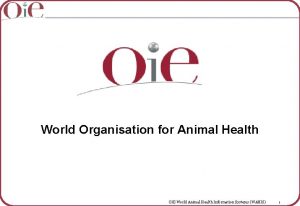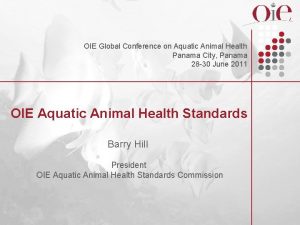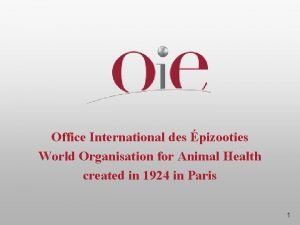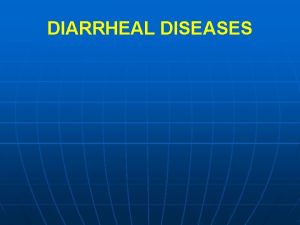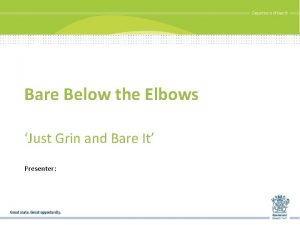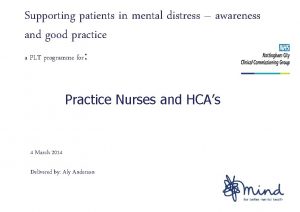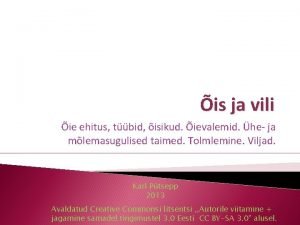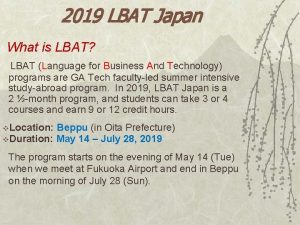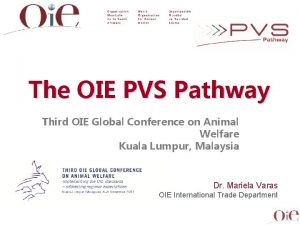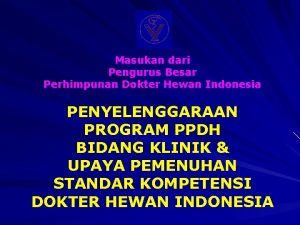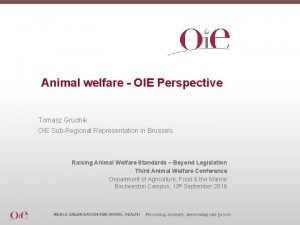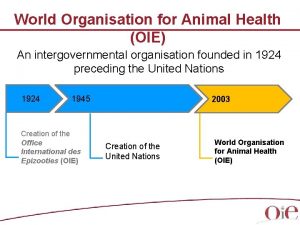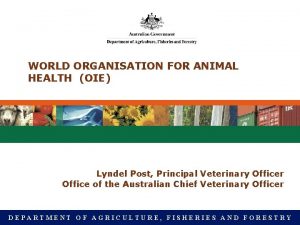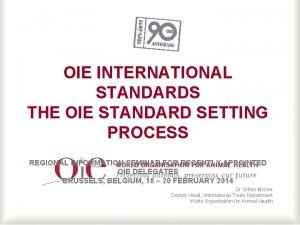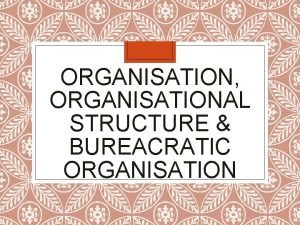INTERNATIONAL REQUIREMENTS WORLD ANIMAL HEALTH ORGANISATION OIE Presented
![INTERNATIONAL REQUIREMENTS: WORLD ANIMAL HEALTH ORGANISATION [OIE] Presented By: Dr M. Modisane INTERNATIONAL REQUIREMENTS: WORLD ANIMAL HEALTH ORGANISATION [OIE] Presented By: Dr M. Modisane](https://slidetodoc.com/presentation_image/103b0ccc04a3fb45f94146ced5fc622a/image-1.jpg)












- Slides: 13
![INTERNATIONAL REQUIREMENTS WORLD ANIMAL HEALTH ORGANISATION OIE Presented By Dr M Modisane INTERNATIONAL REQUIREMENTS: WORLD ANIMAL HEALTH ORGANISATION [OIE] Presented By: Dr M. Modisane](https://slidetodoc.com/presentation_image/103b0ccc04a3fb45f94146ced5fc622a/image-1.jpg)
INTERNATIONAL REQUIREMENTS: WORLD ANIMAL HEALTH ORGANISATION [OIE] Presented By: Dr M. Modisane

Overview 1. Introduction: The World Organisation of Animal Health (OIE) 2. The Terrestrial Animal Health Code on Animal Welfare 3. Guiding principles for animal welfare 4. Scientific basis for OIE recommended welfare standards 5. Existing OIE Recommended Welfare Standards 6. Welfare responsibilities of the Competent Authority 2

1. Introduction: The World Organisation of Animal Health (OIE) v It consists of members states; v The OIE develops various standards for improvement of animal health, welfare and veterinary public health through member states participation v The developed standards are recommended to member states in the Terrestrial Animal Health Code (hereafter Terrestrial Code) v These recommended standards are science-based or evidence-based v OIE Terrestrial Code standards are recognised by the World Trade Organisation for trade purposes v Adoption of these recommended standards is therefore an enabler for trade and market access 3

2. Overview: Terrestrial Code on Animal Welfare (Chapter 7) v Animal Welfare Definition: v *Animal welfare means how an animal is coping with the conditions in which it lives. v An animal is in a good state of welfare if (as indicated by scientific evidence) it is healthy, comfortable, well nourished, safe, able to express innate behaviour, and if it is not suffering from unpleasant states such as pain, fear, and distress. v Good animal welfare: v *requires disease prevention and appropriate veterinary treatment, shelter, management and nutrition, humane handling and humane slaughter or killing. Animal welfare refers to the state of the animal; the treatment that an animal receives is covered by other terms such as animal care, animal husbandry, and humane treatment. *2017 © OIE - Terrestrial Animal Health Code - 25/07/2017 4

3. Guiding principles for animal welfare a) The state of an animal’s welfare is a determinant of it’s health b) The ‘five freedoms’ provide valuable guidance in animal welfare: v Freedom from hunger, thirst and malnutrition; v Freedom from fear and distress; v Freedom from physical and thermal discomfort; v Freedom from pain, injury and disease; and v Freedom to express normal patterns of behaviour c) The ‘three Rs’ provide valuable guidance for the use of animals in science v Reduction in numbers of animals, v Refinement of experimental methods and v Replacement of animals with non-animal techniques 5

3. Guiding principles for animal welfare (continued) d) The scientific assessment of animal welfare involves diverse elements which often involves value-based assumptions. Assumptions must be explicit e) The use of animals by man makes a major contribution to ‘his’ wellbeing f) Animal use carries an ethical responsibility to ensure their welfare to the greatest extent practicable g) Improvements in farm animal welfare can improve productivity, food safety and economic benefits h) When comparing animal welfare standards and recommendations, rather us equivalent animal-based outcomes than use of identical systems design. 6

4. Scientific basis for OIE recommended welfare standards 1) Welfare is a broad term which includes the many elements that contribute to an animal’s quality of life, including those referred to in the ‘five freedoms’ listed above. 2) The scientific assessment of animal welfare has progressed rapidly in recent years and forms the basis of these recommendations. 3) Some measures of animal welfare involve assessing the degree of impaired functioning associated with injury, disease, and malnutrition. Other measures provide information on animals’ needs and affective states such as hunger, pain and fear, often by measuring the strength of animals’ preferences, motivations and aversions. Others assess the physiological, behavioural and immunological changes or effects that animals show in response to various challenges. 4) Such measures can lead to criteria and indicators that help to evaluate how different methods of managing animals influence their welfare. 7

5. Existing OIE Recommended Welfare Standards 1. Transport of Animal by Sea 2. Transport of Animals by Land 3. Transport of Animals by Air • These recommendations apply to the following live domesticated animals: cattle, buffaloes, camels, sheep, goats, pigs, poultry and equines. They will also be largely applicable to some other animals, e. g. deer, other camelids and ratites. 8

5. Existing OIE Recommended Welfare Standards (continued) 4. Slaughter of Animals § These address the welfare of food animals during preslaughter and slaughter processes, until they are dead. § They apply to abattoir slaughter of domestic animals § All other animals slaughtered outside abattoirs should be managed to ensure that their transport, lairage, restraint and slaughter is carried out without undue stress 9

5. Existing OIE Recommended Welfare Standards (continued) 5. Killing of Animals for Disease Control Purposes § When a decision to kill the animals has been made, ensure the welfare of the animals until they are dead. 6. Stray Dog Population Control § Promotion of responsible dog ownership can significantly reduce the numbers of stray dogs and the incidence of zoonotic diseases. § Control of stray dog populations has to be accompanied by changes in human behaviour to be effective (dog ecology is linked with human activities). 10

5. Existing OIE Recommended Welfare Standards (continued) 7. Use of Animals in Research and Education • Emphasis on Three Rs where animals are used. 8. Beef Cattle Production Systems § These apply to all commercial cattle production systems (except veal) where the purpose of the operation includes some or all of the breeding, rearing and finishing of cattle intended for beef consumption. 9. Broiler Chicken Production Systems § Apply for species Gallus gallus kept for commercial meat production, excluding village or backyard 11

5. Existing OIE Recommended Welfare Standards (continued) 10. Dairy Cattle Production Systems § Applies for all commercial cattle production systems where the purpose of the operation includes breeding, rearing and management of cattle intended for production of milk. 11. Welfare of Working Equids • Applies to equids: » used for transport and traction in production and commercial activities. » providing draught power, manure, milk, meat and hides for household use. 12

6. Welfare responsibilities of the Competent Authority 1. Establishing minimum standards for animal welfare, including requirements for inspection of animals before, during and after their travel, defining ‘fitness to travel’ and appropriate certification and record keeping; 2. Setting standards for facilities, containers and vehicles for the transport of animals; 3. Setting standards for the competence of animal handlers, drivers and managers of facilities in relevant issues in animal welfare; 4. Ensuring appropriate awareness and training of animal handlers, drivers and managers of facilities in relevant issues in animal welfare; 5. Implementation of the standards, including through accreditation of / interaction with other organisations; 6. Monitoring and evaluating the effectiveness of standards of health and other aspects of welfare; 7. Monitoring and evaluating the use of veterinary medications; 8. Giving animal consignments priority at frontiers in order to allow them to pass without unnecessary delays 13
 Oie world organization for animal health
Oie world organization for animal health Oie aquatic animal health code
Oie aquatic animal health code Office international des épizooties
Office international des épizooties World health organisation
World health organisation World health organisation
World health organisation World health organisation bare below the elbow
World health organisation bare below the elbow World health organisation
World health organisation World health organisation
World health organisation World health organisation
World health organisation Isas õite kogum
Isas õite kogum Oie gatech
Oie gatech Oie pvs tool
Oie pvs tool Oie delegates
Oie delegates 33 profesi dokter hewan menurut oie
33 profesi dokter hewan menurut oie
